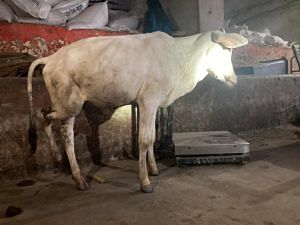Hundreds of happy cows lowing in unison, swishing their tails gently, verdant meadows dotted with natural ponds, their clear water reflecting the vivid blue skies above, and tourists roaming around watching the bovines in their ‘natural surroundings’. That was the dream when the Yogi Adityanath government came up with the idea of cow safaris in December 2017.
Around five years on, the ambitious project is yet to take off. The reality—a far cry from the postcard perfect Swiss chalet ideal—is one of limping old cows, vacant sheds, and angry workers.
“Gau mata slogans are raised, but trees have been planted in the area mandated for fodder. The authorities say there is no money. I haven’t been paid my salary for four months,” said Arun (name changed), one of the workers or ‘Gau Sewak’ at Madhwaliya Gau Sadan in Maharajganj district of Eastern Uttar Pradesh.
As the third largest cow shelter in the state in terms of area, Madhwaliya Gau Sadan was identified as one of the 31 possible locations for a cow safari. The decision raised the flagging morale of staff, who hoped that things would improve.
With about 500 acres of green pastures, Madhwaliya village was the perfect site to roll out the safari. But so far, nothing has happened, and discontent is brewing at the cow shelter.
Also Read: Next generation of Indians should be encouraged to take up farming, says RSS general secretary
Bleak reality
An unusually large number of the 635 cows at the shelter are either injured or old. Ram Kishore, another worker, points to a calf that is limping painfully. “Usually, animals injured in accidents are brought here, but most are those that have been abandoned because they no longer give milk. Often people quietly leave their cattle outside the Sadan and run away,” he said.

All 26 staff members—24 gau sewaks and two supervisors—are angry and frustrated with the state of the shelter, lack of staff, and non-payment of salaries.
Frequent deaths of cows is another demoralising factor.
According to supervisor Ramu Yadav, about 20 cattle at the Sadan die every month, most of them “ill and injured”. Several of these are brought from the city, where they are used to consuming plastic waste. Lack of medical equipment and stretchers means the cows die “while being pulled and loaded” onto the tractor-trolley in order to be brought to the Gau Sadan, Yadav said.
It’s not just payments that have been delayed; tenders for the only profit-making venture in the shelter, the vermicompost plant, are pending as well.
At first, Arun is reticent, but with a little prodding, he joins the conversation with all guns blazing.
“While we wait for the tenders, cow dung is lying everywhere,” he said, pointing towards the heaps of dung strewn on the pastures.
Deputy Chief Vigilance Officer (CVO) Dilip Singh, who is also in charge of the Gau Sadan, said that tenders of Rs 15 lakh had been issued for purchase of vermicompost about two years ago. “The payment has been coming in parts and a portion of it is still pending,” he said.
Singh, as well as the workers, said that senior government officials are aware of the problems the shelter is facing.
On 5 July, UP social welfare minister Sanjeev Gaur, along with district administration officials, planted hundreds of trees on land meant to grow fodder. “The forest department and the minister have planted trees here, which should not have happened. How will we grow fodder?” says Mahendra, who has been working at the shelter since the 1990s.
Also Read: Adityanath conducts aerial survey of Kanwar Yatra, showers petals on Kanwariyas
Yogi’s cow safari push

Madhwaliya Gau Sadan was allotted 500 acres of land in 1970, but it started functioning only in 1997, with 35 cattle. The number kept increasing and by 2017, the shelter was home to around 400 cattle. Until the Adityanath government came to power that year, around 145 acres of land was being used to plant fodder.
Things started looking up with Adityanath at the helm. Measures to protect cows and crackdowns on slaughterhouses gained momentum. But then, in 2019, the management of the Madhawaliya Gau Sadan changed hands – from being privately run, it came under government control – and things took a strange turn.
In October 2019, as many as 1,546 cows at the shelter went ‘missing’. A physical verification found only 954 stray cattle at the Sadan as against 2,500 strays registered in its records.
As the management failed to explain the discrepancies, the Adityanath government suspended five officials, including Maharajganj District Magistrate Amarnath Upadhayay, and instituted an inquiry into the functioning of the Gau Sadan. They uncovered rampant corruption—148 acres of land was leased out to just two persons to grow fodder. But instead of growing fodder, they were using it for commercial farming.
Less than two months after action was taken against the officials, UP animal and husbandry minister Laxmi Narayan Chaudhary took the matter of setting up cow safaris in the state. Taking cue from neighbouring Madhya Pradesh—the first state to come up with a cow sanctuary in India—officials started identifying land for construction of compounds where cattle could graze freely and cow-lovers could come for ‘darshan’. “The aim was to generate funds and make the cow shelters self-reliant,” a government official said.
But the project remained in discussions. It was revived in April this year, and proposals were sought from districts with at least 50 acres of available land.
Given that the Madhwaliya Gau Sadan has the most land among the over 5,000 cow shelters of UP, DM Satyendra Kumar sent a proposal to set up a cow safari in Maharajganj in May. So far, nothing has happened on the ground, and the cow shelter continues to deal with fund crunch.
Also Read: Milking tech: IIM Ahmedabad paper proposes face recognition tool to modernise cow-based economy
Moving toward self-reliance
The Sadan is run on the income it generates from sale of vermicompost, donations from non-governmental organisations (NGOs) and visitors. This year, it received Rs 4 lakh from the Red Cross Society while it got Rs 2-3 lakh the previous year from other groups, said Deputy CVO Singh.
Three of the sheds—which are government aided and where every cow gets a designated Rs 30 from the state—house 504 cattle. But workers say that the money is not enough to cover their expenses. The remaining 131 cows are packed into another shed, while the rest lie vacant.
“The rules of Madhwaliya Gau Sadan’s committee, which were formalised in the 1970s, said that it will be funded by donations from social groups and visitors. We recently introduced another clause so that it is able to generate funds for itself,” said DM Kumar.

A cow safari will help the shelters become self-reliant—a goal that has been reiterated by Adityanath in several statements. “If people visit here and interact with cows, footfall will increase and funds will also increase,” Singh added.
Besides Maharajganj, Jalaun and Shahjahanpur districts have also sent similar proposals to the state government’s request for ideas on cow safaris. But there too, nothing has taken off.
Principal Secretary Rajneesh Dubey claimed that some districts were undertaking the project “at their own level.” However, official sources confirmed that the districts are awaiting the state government’s nod to move ahead with the project.
Meanwhile, the Madhwaliya Gau Sadan, which accepted stray cattle from ten districts of UP, has stopped taking in more strays. There are no funds. “Now, we only allow stray cattle from within the Maharajganj district,” said DM Kumar.
The saying ‘till the cows come home’ just took on a whole new meaning in Uttar Pradesh.
(Edited by Zoya Bhatti)






